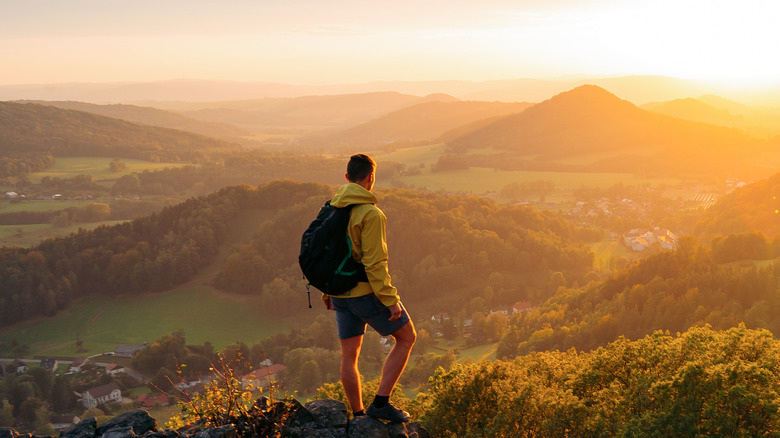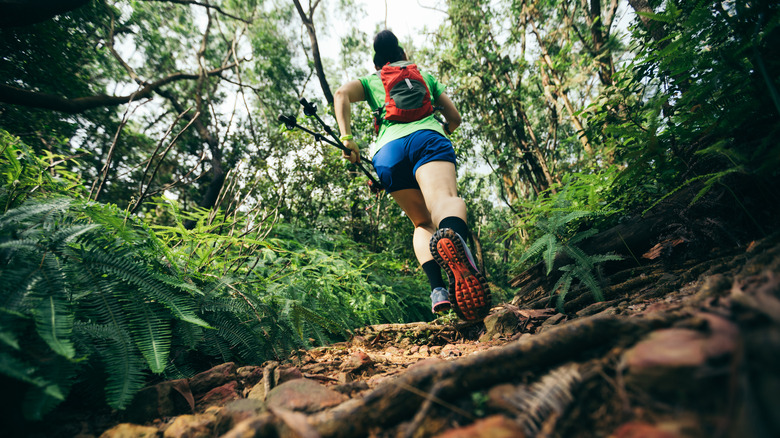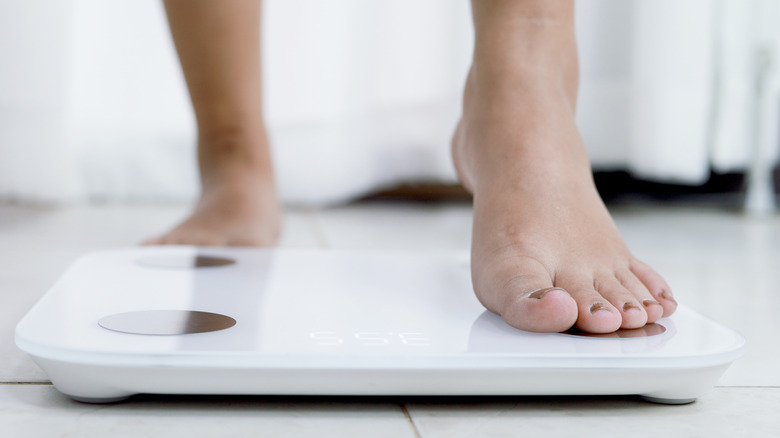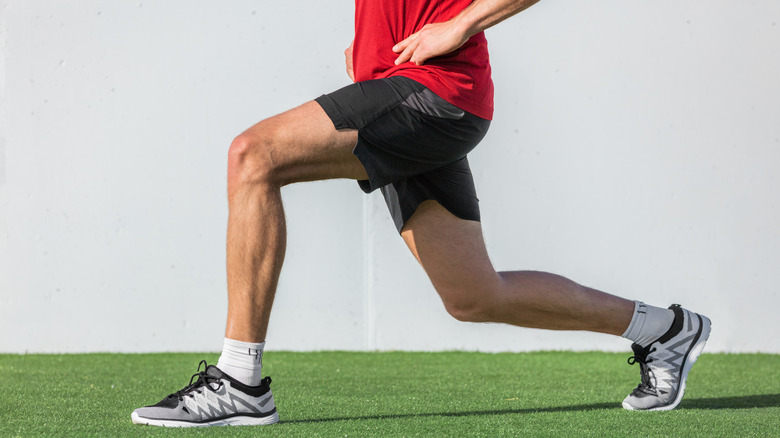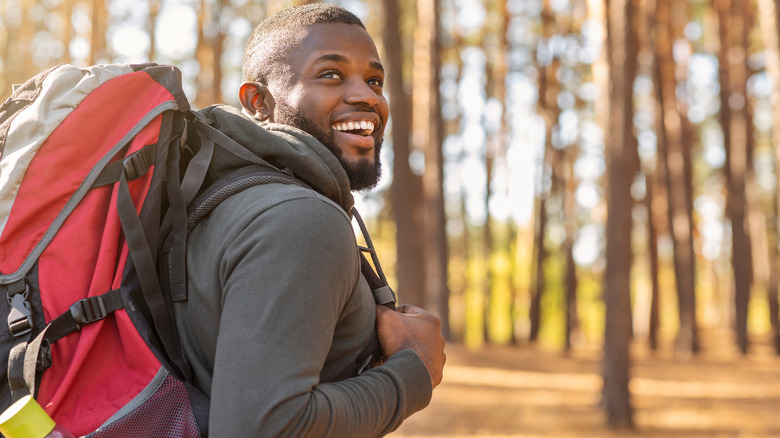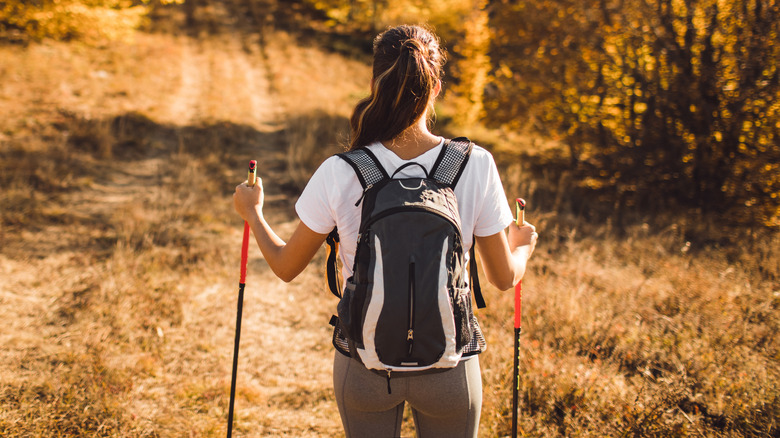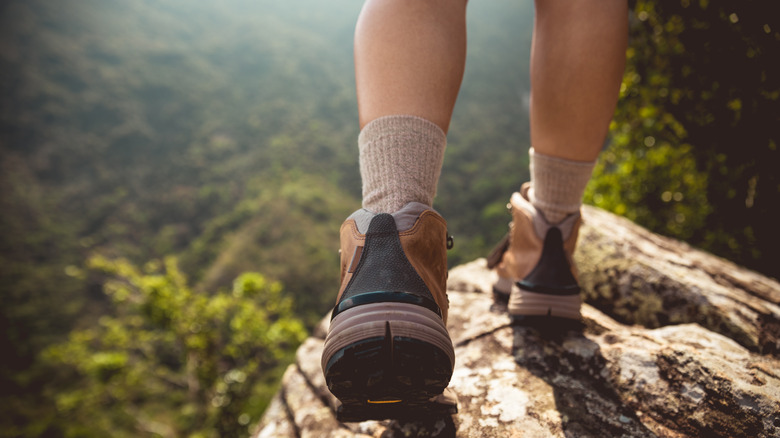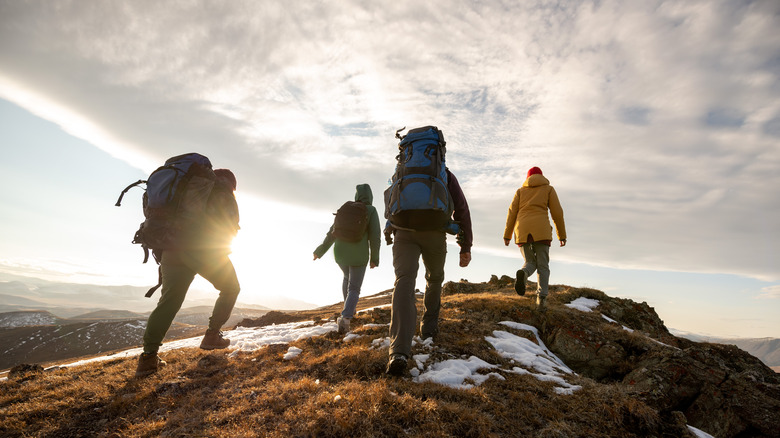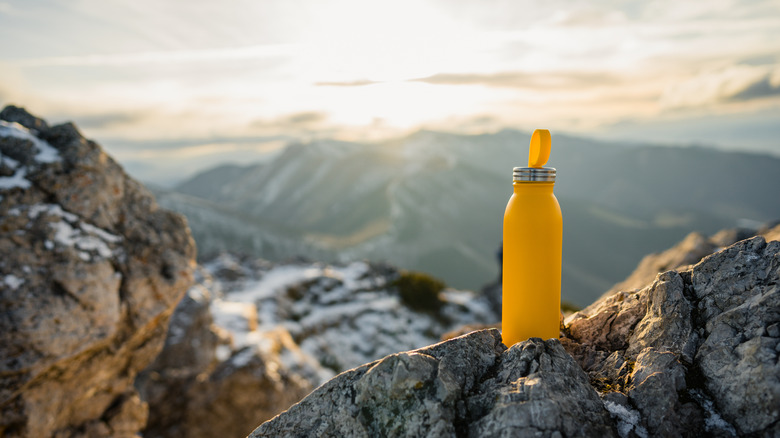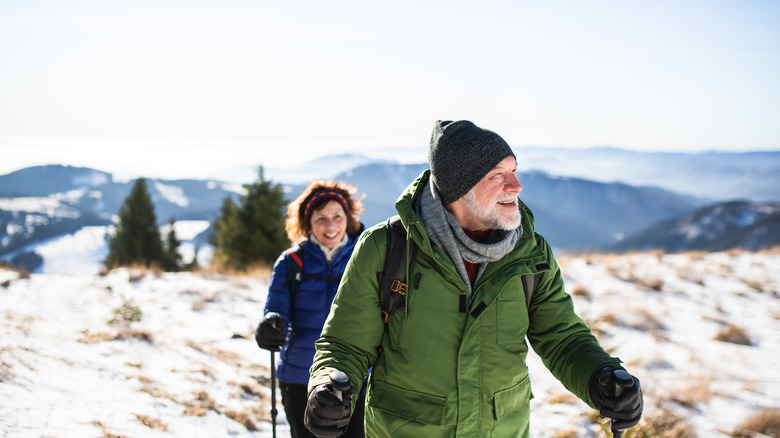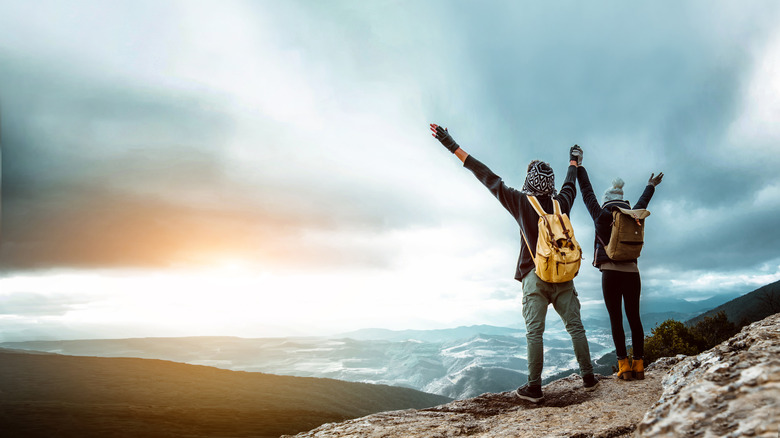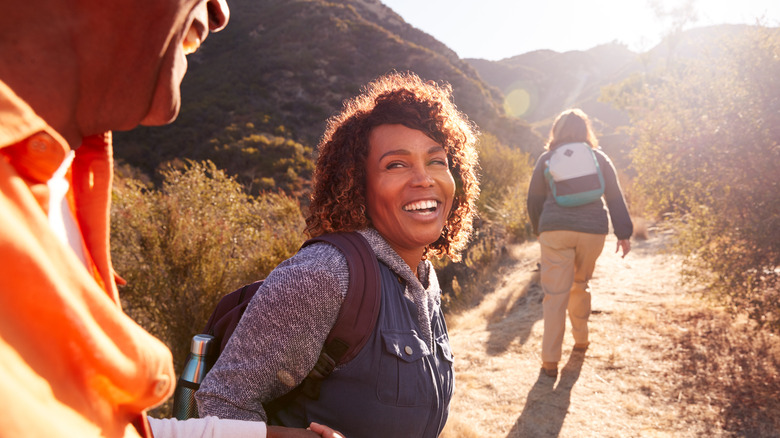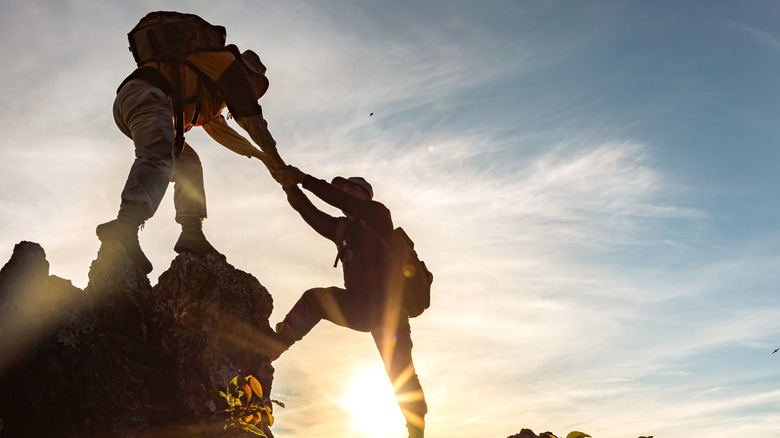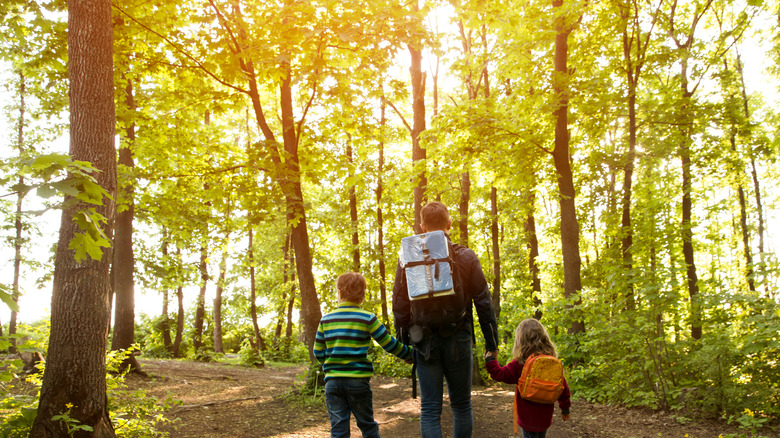What Happens To Your Body When You Hike Every Day
We all know that cardiovascular health is important, but what if you get bored on the treadmill or elliptical at your indoor gym? The weather may force you to stick indoors for exercise, but during the right time of year, getting outside for a hike on a regular basis can be healthy for both your body and mind.
When you think of a "hike," you may think of scaling large mountaintops, but that's not the only way to do it. A hike can be done at any pace and varying difficulties, making it easy for all ages and potentially low impact. While you shouldn't expect your body to immediately adjust to daily hikes, it is important to make hiking a regular part of your routine to reap all the health benefits. Going on one hike every few months won't provide the same output as hiking on a regular basis. But staying safe from injury is equally as important, as hiking does have the potential to be dangerous due to a number of factors (via AccuWeather).
Let's take a look at how daily hiking can affect your body — both the positive ways and the not-so-positive ways, too.
You improve your heart health and build your endurance
Hiking usually entails going uphill and downhill a moderate amount. This deviation from the "flat road" walking on a treadmill or paved trail means you are boosting your cardiovascular health and building your endurance at the same time. Being a highly cardiovascular exercise, hiking can reduce the risk of cancers, heart disease, high blood pressure, high cholesterol, stroke, and more (via Piedmont Healthcare).
But what type of effort do you need to put in to get the best cardiovascular health benefits? You'll want to get your heart beating between 50 to 70% of your maximum heart rate during a moderate-intensity hike (via Better Health Channel). "If you can comfortably talk, but not sing, you're doing moderate intensity activity," the site advised.
You may even build your endurance because you don't realize that you're going as far of a distance. Being outdoors can be distracting — and in a good way! "Exercising outdoors has been found to be easier in that you feel less fatigue or pain and can go faster and longer than if you were indoors," physician Eva Selhub told Shape. This means you may not groan out of boredom while on a 30-minute hike outside as you would indoors on the treadmill.
You may lose weight
Many work out to hit their weight-loss goals — and burning calories is a metric commonly used in weight-loss plans. A weight-loss journey can be as simple as eating fewer calories combined with burning calories through exercise (via Mayo Clinic).
But how does this relate to hiking? We use stored energy, or calories, as fuel during physical activity — and hiking's specific needs can result in more of a calorie burn, explained the Washington Trail Association. A study in the Journal of Experimental Biology found that walking on uneven terrain, like nature trails, prompts our body to use 28% more energy due to how you must shift your leg muscles around uneven ground. This extra effort exertion in turn can lead to more calories burned, and thus greater weight loss.
The exact amount of calories you will burn depends on multiple factors including your pack's weight, how fast you are going, and the difficulty of your trail. To give you a general idea, a moderate hike will burn 300 to 400 calories an hour, according to the Washington Trail Association.
You develop stronger leg muscles
You have probably used the various machines at the gym designed to strengthen your legs, but every hike can essentially be a "leg day" workout. Hiking acts as a natural leg press or stair climber for your calves, gluteus maximus, hamstrings, and quadriceps. And the best part is hiking includes that coveted downhill motion, which really leaves your legs feeling like Jell-O.
"To go downhill, your glutes and quads need to do a lot of slow, controlled work to stabilize your knees and hips so you don't fall," Joel Martin, assistant professor of exercise, fitness, and health promotion at George Mason University, told Shape. "These types of contractions [called eccentric contractions; the same kind your muscles experience when you slowly lower a weight at the gym] damage muscle fibers the most because you're resisting the force of gravity against weight, which in this case is the weight of your body."
It is important to note that hiking may not heed the same results as bodybuilding, but over time, you should see results in muscle tone. Hiking uses even more muscles than the 200 muscles it takes to make one step (per Gear Up Hiking).
You build core strength
Hiking is typically thought of as heavy on the lower body, but you may not realize you are actually working your core. Strong core muscles are key in daily activities and are important for athletes (including hikers and runners) for preventing fatigue and injuries, revealed Mayo Clinic. But this doesn't mean you have to stick to crunches indoors.
Hiking in particular is great for tightening your core muscles as you balance and stabilize yourself on different terrain. In fact, your abs and lower back matter more for carrying a hiking backpack and keeping your spine safe (via Backpacker).
Working those abdominal muscles during a hike will keep your posture in the upright position while supporting your back and eliminating possible injury, per Total Hiker. There are even exercises you can do off of the trail to boost your ab strength and make your hikes a more enjoyable experience.
You can even work your upper body while hiking
Wanting to make your hike a full-body workout? Grab some trekking poles to give your upper body some love. Not only will the poles have you working your arm muscles, but they'll also provide you with some added stability while you walk over uneven terrain.
But how could a couple of poles really be an effective arm workout? Well, the use of hiking poles provides arm strengthening and toning, as the lower resistance "pull" motion it takes to use walking poles serves as a gentle strength-training workout, Earth Trek Gear explained. One study even found that using hiking poles while walking increased hand grip and arm curl strength over the course of 12 weeks (via Earth Trek).
Another perk of hiking with trekking poles is that you will more evenly distribute your body weight from your lower body joints to your arms, saving your lower body some energy. According to Prevention, it can even increase your calorie burn by 15 to 20%.
Hiking serves as cross-training
The saying "variety is the spice of life" carries over into exercise, too. Cross-training is an important part of any athletic plan. Even if you are very fit in a cardiovascular sense and run or cycle on a regular basis, hiking can still provide you with some extra benefits.
"Cyclists tend to have strong quads but underdeveloped hamstrings, and runners tend to have weak hamstrings and glutes," Joel Martin, assistant professor of exercise, fitness, and health promotion at George Mason University, acknowledged when speaking with Shape. "Hiking helps strengthen these muscles to eliminate those types of imbalances."
Hiking can be especially helpful for runners who typically train on pavement, as that can be taxing on the joints (via Runner's World). Using a different set of muscles for stabilization can also serve as injury prevention. Plus, it can be a change in pace for those who want to get their heart rate up but don't want to add more mileage to their daily runs or cycling routines.
You get a more intense workout at higher elevations
Hiking is generally done on trails with varying elevation. And that elevation change can serve as a workout in itself. Working out at higher elevations forces you to exercise with less oxygen, which may be difficult — at least at first. Over time, your body will get used to the intensity, making flat-road workouts seem easy!
Research backs this up. According to a study in the Journal of Applied Physiology, male endurance runners who exercised at high altitudes two times a week for six weeks took a whopping 35% longer to tire compared to runners who exercised at sea level (via Washington Trail Association).
But don't go seeking those high mountaintops quite yet. You do still want to give yourself time to get acclimated, as altitude sickness can occur if you walk or climb to a higher elevation too quickly. This is mostly a factor if you are exercising at 8,000 feet elevation or above, but it can be very dangerous, according to WebMD.
You can become dehydrated or fatigued if you don't fuel up properly
Whether it be a short jaunt in the woods or an ultra trail run, preparation is key — especially when it comes to water. Any hike can turn longer than expected due to the weather, injury, or simply getting lost. Dehydration is a big concern, especially if you are hiking in a desert climate with sun exposure.
While you don't want to carry so much water that it weighs down your pack and causes you to exert a ton of energy, you do need to bring enough water. The hydration process should begin before you even start your hike. In desert climates, you should aim to drink at least three liters during the day (via Your Hike Guide). It is also important to note that water weighs about 2 pounds a liter, so keep that in mind when loading your pack (via Embracing the Wind). If you have questions about hydration and nutrition, consult with your medical professional team to get a health plan specific to your needs.
Hiking benefits your physical health in ways you may not realize
Getting outside in nature to hike has other physical perks than just a workout. Just being outside provides access to vitamin D from sunlight. Researchers say combining vitamin D and exercise can provide heart health benefits that can protect your cardiovascular system (via Johns Hopkins University).
Breathing in the fresh air can not only feel good, but actually cause good for the body. Hiking outdoors can decrease the risk of some respiratory problems, according to the National Park Service. Even just a quick 30-minute hike can increase your lung capacity, the Lung Health Institute confirmed. And even though hiking can be a tough workout on your lower body, its weight-bearing traits boost your bone density, building your muscle mass and helping prevent osteoporosis. And if you have arthritis, it can help you become "more limber and mobile," explained Piedmont Healthcare.
Hiking may also reduce the risk of developing diabetes and reduce the need for insulin for those who already have diabetes, according to Piedmont. However, you should consult with your medical team before stopping any medications or increasing your exercise.
Mental health perks abound
Hiking is good for your physical health, yes, but it also provides numerous mental health benefits. Just getting outside in nature releases endorphins and serotonin to give you a happiness boost, according to Premier Health. One 2015 study even found that being outside for as little as 90 minutes for a nature walk stops rumination, or brooding, allowing you a real sense of peace.
The outdoors can act as a stress and anxiety reducer and can help combat depression. Susan Kraus Whitborne, professor of psychology, told Shape that even looking at pictures of nature can have stress-reduction factors — so you can imagine what kind of effects actually being out in nature has.
Hiking in more remote areas forces you to unplug from technology, as you may not have phone service. You may even see a boost in your creativity, and see differences in your brain's performance by having a clearer perspective from connecting with nature, according to Seattle Backpackers Magazine.
Hiking can strengthen your relationships
Some of the best things in life are shared with others — and hiking is no exception. While some may like the solitude of walking through the woods alone with their thoughts, you can also integrate hiking into your social calendar. And while you may think of hiking as a benefit to mental and physical health, activities like hiking can have an effect on your relationship health. Hiking can improve your existing relationships, as you build strong friendships by going through challenging activities (via National Park Service).
Outdoor activities like hiking can also serve as a healthy outlet to meet new people in an outing that doesn't focus on eating or drinking. Check out social media or outdoor outfitters in your area to see if there are any existing hiking groups. If not, create one yourself! Alternatively, you can form camaraderie on the trail by striking up a conversation with other hikers. Whether for safety or just to socialize, this is a great way to find out what lies ahead on your trail.
You do expose yourself to certain risks
Not to harp on the negative, but there are some risks to hiking pertaining to your health and safety. Hiking can be a healthy workout for many people, but there are cases in which you'll want to consult with your medical team before you start integrating hiking into your workout routine.
"If you have any type of hypertension or heart disease, be sure to consult your doctor before hiking," Dr. Michael Bednarz, a podiatric surgeon, told Piedmont Healthcare. "Even if you are healthy, climbing vertically can be a whole new ballgame. You use very different muscles than you do on flat surfaces, so be sure to stretch and listen to your body's limits."
Check in with your doctor on a regular basis when upping your hiking mileage to mitigate any health risks. Nutrition is also key, so having a healthy diet that matches how active you are will help fuel your workouts. It is also smart to bring a buddy hiking, especially if it is your first time on a remote trail. Not only can an extra person help you navigate, but you'll have help if you get injured during the hike (via WebMD).
How to get started
Want to start a daily hiking routine but not sure where to begin? Experts say preparation is key. You will want to start small with trail lengths and difficulties, sticking with simple hikes until you feel more comfortable. You'll also want to get the right gear for your climate to prevent injury and learn to pack according to the weather, advised WebMD. Another big consideration is how to fit in hiking to your normal routine. Gear Up Hiking recommends starting with a short walk at the same time each day, keeping an activity log to hold yourself accountable. Over time, you can build on your endurance and find time to go on longer strolls.
An important aspect of hiking every day is taking care of your body. Be sure to warm up and cool down before and after each hike, lightly stretching if that feels good for your body. You should be cognizant of your need for rest and take breaks when necessary. Recovery is imperative to truly build long-term strength, so if you never give your body a break you could end up with injury or illness (via Washington Trail Association).
The most important tip of all: Have fun! Don't force unrealistic expectations on yourself if you're a hiking novice and be patient with your progress. Remember that any time spent strolling outdoors can be good for your mental and physical health.

